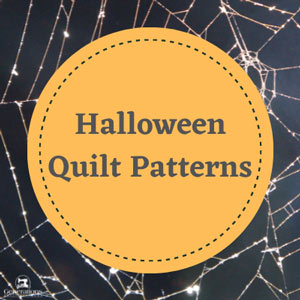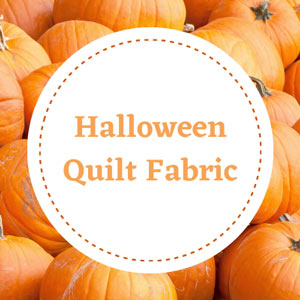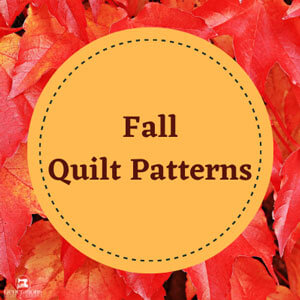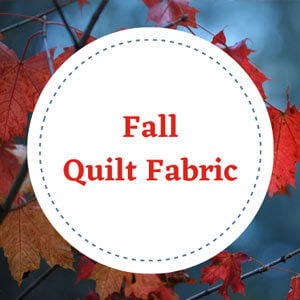This post contains affiliate links for which I receive compensation
Quilt over embroidery for a baby quilt?
by Karen
(Florida)
I have made a baby quilt out of 12 squares (8x8) of little "girls in bonnets", and I don't know whether to quilt across the whole quilt, including the embroidery, or do some kind of free motion quilting in the columns and rows between the squares.
This is my first quilt on my own and I have no idea whether I can do free motion or not. :(
Reply
There have been several questions into the website asking how to quilt quilts made from embroidered blocks. It all depends on how the quilt will be used, laundered and how much time you want to put into the quilting.Machine stitched example
My experience is with machine-embroidered quilt blocks like the flannel 'Kitty Quilt' shown below.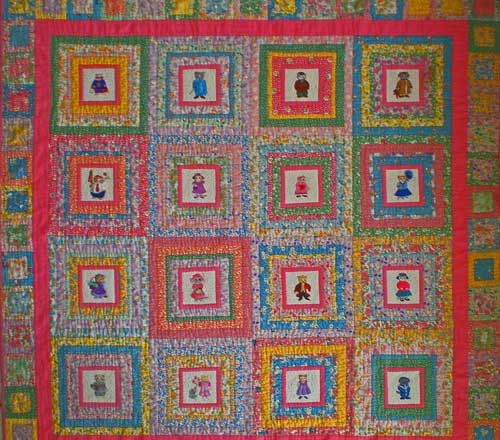
For these densely stitched blocks, I chose to 'stitch in the ditch' around the embroideries and then stipple quilt the background.
Here's a close-up.
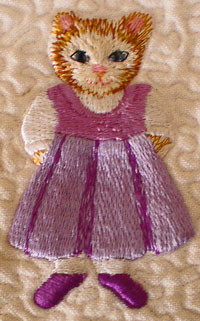
My reason for using so much quilting behind the blocks is because this quilt was intended to be used by my daughter when she was four (she's now almost fifteen - don't know where the time went). With all this stippling, the individual stitches aren't stressed as much and will hold up better over time.
Knowing how you intend or expect your quilt to be used and cared for says a lot about how you'll quilt it.
Not a lot of use, say it will hang on the wall, you can use less quilting.
Don't intend to wash the quilt? There'll be less wear and tear on the fabric and the stitches if it's not washed weekly. You can do less quilting.
Just be sure to sure to use a batting where the manufacturer's recommended maximum stitch distance is greater than the size of your blocks. Both Warm and Natural and Quilter's Dream Cotton are rated at 8 inches or more between quilting stitches. Both would be good choices for your quilt.
Hand stitched example
In this redwork quilt (hand embroidered by Jean Casey and pieced and quilted by Debbie Spencer), instead of stippling the background, the quilter has grid quilted using her walking foot...perfect if you are not quite ready to do free motion quilting on a real quilt.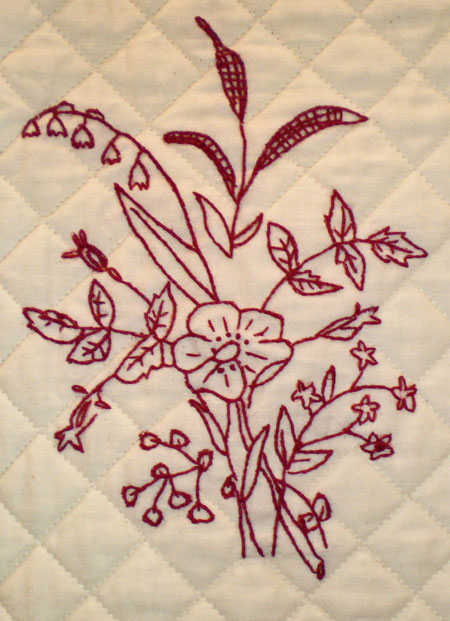
Can you see that the grid doesn't cross over the hand stitched design, except just a stitch or two in a couple of places? The quilter did a beautiful job of quilting this.
The straight lines of the grid, again, can be stitched with a walking foot so you don't need extra practice for that as a beginning quilter.
Those lines are a nice complement to the curved lines in the stitching.
And because she hasn't stitched over the design, but only up to it, the hand stitching--which is the star of the quilt--can come forward visually. The quilting emphasizes the handwork.
An all-over pattern stitched over the whole surface of the quilt makes your hand stitching and background visual equals...they're both on the same level.
You may find these other pages helpful in making your quilting decision:
Readers, do share your thoughts and experiences with quilting both hand and machine stitched embroideries by commenting below.
Thank you!
I hope this information gives you some ideas to move forward with your project!
Piecefully,
Julie Baird
Editor
Comments for Quilt over embroidery for a baby quilt?
|
||
|
||





